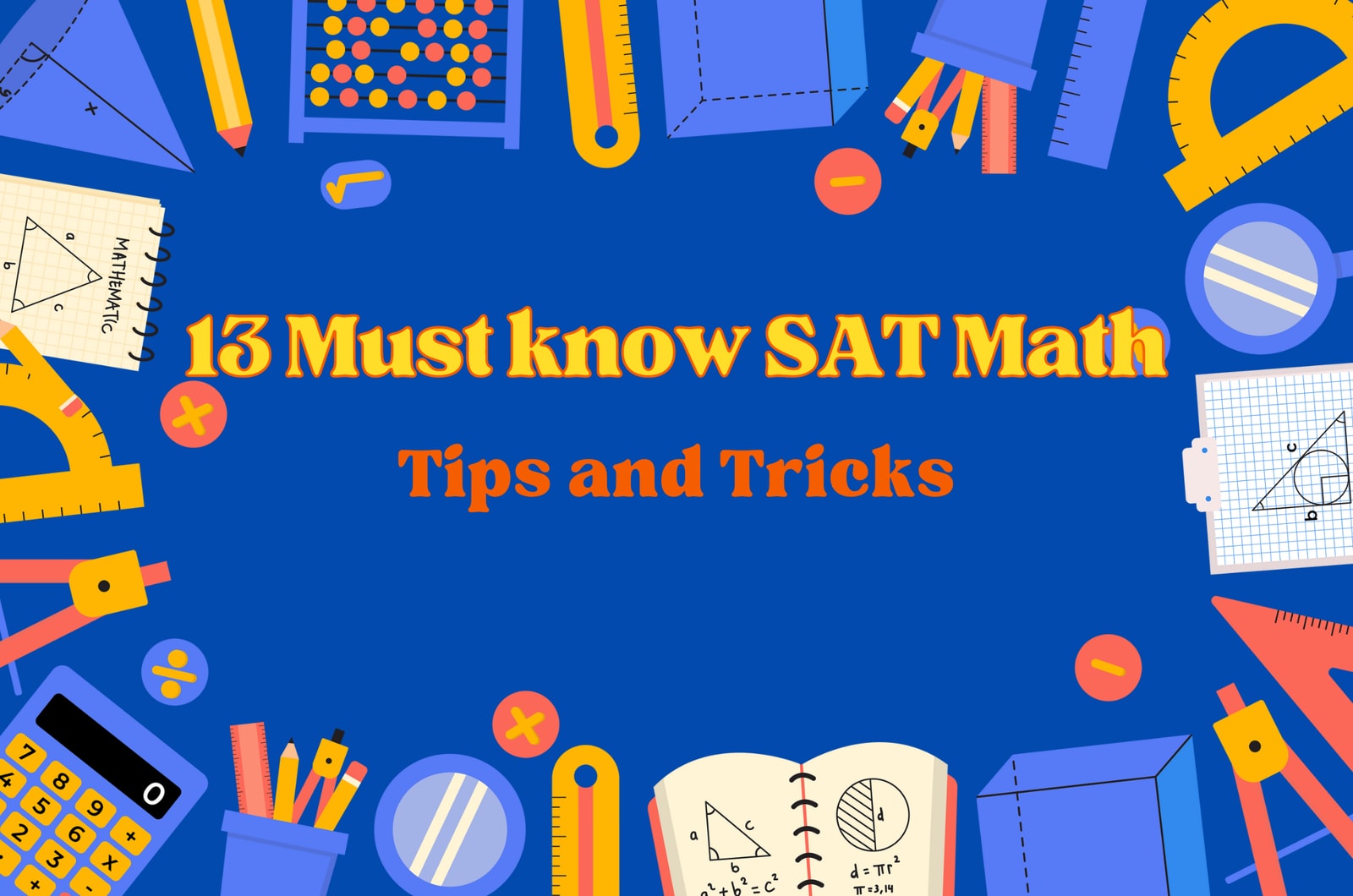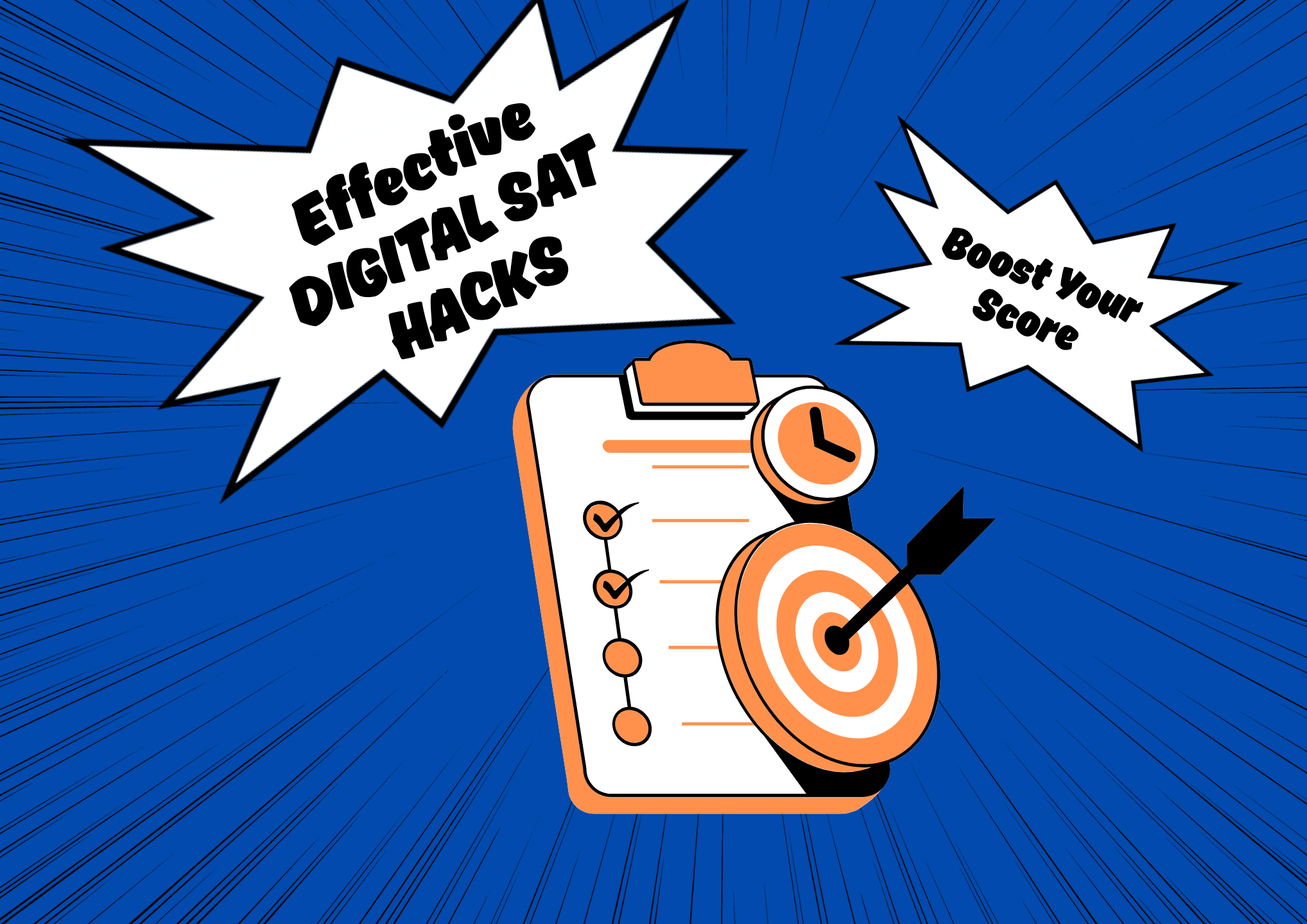13 Must-Know SAT Math Tips and Tricks for the 2025 Digital SAT
Author
Phoenix Wilder
Date Published

Preparing for the Math section of the 2025 Digital SAT can feel overwhelming — but with the right strategies, it’s a challenge you can conquer. This guide offers expert tips, study strategies, and last-minute tactics to help maximize your SAT Math performance.
Whether you’re months away from your test date or making a final push in the last few weeks, these methods will help you feel more confident and prepared.
1. Overview of the SAT Math Section (2025 Digital SAT)
Before diving into strategies, let’s review how the Digital SAT Math section works, so you know exactly what you’re up against.
The SAT Math section tests knowledge across four math domains:
1. Algebra – Linear equations, inequalities, and functions.
2. Advanced Math – Non-linear equations, polynomials, and more complex problem-solving.
3. Problem-Solving and Data Analysis – Ratios, percentages, statistics, and interpreting graphs & tables.
4. Geometry and Trigonometry – Angles, circles, triangles, and basic trigonometric functions.
Here’s the approximate question breakdown:

Digital SAT Math format:
· 40 total questions
· 70 minutes total, split into two adaptive modules
· Calculator allowed for ALL questions (including the built-in Desmos calculator on the test platform)
· Adaptive modules mean the second module’s difficulty changes based on your first module performance.
Why this matters: Pacing and accuracy in the first module are crucial, because performing well in Module 1 unlocks higher-difficulty questions in Module 2 — which can yield more points.
2. Tips for Before the SAT Math Test
Tip 1: Know Exactly What Will Be Tested
A surprising number of students feel lost in SAT prep simply because they don’t know the specific skills being assessed. The SAT Math is not a test of memorizing obscure formulas; it’s about applying concepts to new situations.
Action step: Download the College Board’s official SAT Math Domains breakdown or review the skills list from an SAT prep book. This will help you focus your study time on tested concepts rather than wasting hours on irrelevant material.
Tip 2: Practice, Practice, Practice (in the Digital Format)
Practice is your most powerful tool. But quality practice matters more than quantity.
Here’s a proven approach:
· Take full-length digital practice tests in the same time limits as the real SAT.
· Use both College Board’s Bluebook™ app and reputable third-party adaptive practice tests (e.g., BEST SAT Score’s Adaptive SAT Tests) to simulate test conditions.
· Review mistakes thoroughly — understand why you got a question wrong.
Recommended Digital Practice Tools:
· Bluebook™ Official Practice (free from College Board)
· Adaptive Full-Length SAT Practice Tests (BEST SAT Score):
1. Realistic Experience – Replicates actual digital test format
2. Adaptive Difficulty – Adjusts in real time for efficient learning
3. Detailed Score Reports – Pinpoint strengths & weaknesses
4. Targeted Recommendations – Guides you on what to study next
Tip 3: Teach the Material
One of the fastest ways to master a concept is to explain it to someone else. This forces you to organize your thoughts, clarify definitions, and spot gaps in your understanding.
If you can’t find a study partner:
· Teach the concept to yourself out loud
· Create a short “explainer video” as if you were tutoring another student
· Write step-by-step solutions as if creating a guide for a younger student
Tip 4: Manage Your Study Time Wisely
Consistency beats cramming. Break your prep into daily chunks:
· 20–30 minutes for targeted practice in your weakest areas
· 20–30 minutes for mixed review of previously studied topics
· One full-length practice test every 1–2 weeks as you approach the exam
During study time:
· Silence your phone & block distracting websites
· Keep your calculator handy
· Track your progress in a prep journal
Tip 5: Focus on Weak Points… Relentlessly
Many students stick to topics they’re already good at because it feels comfortable — but that’s not how you’ll improve your score. Instead:
· Identify your bottom 2–3 topics (e.g., interpreting scatterplots, working with quadratic functions)
· Drill those topics daily using question banks
· Revisit them every few days to reinforce improvement
Tip 6: Memorize Key Equations & Concepts
Although the SAT provides some formulas at the start of the section, not everything is included. Having them memorized saves time and can prevent costly mistakes.
Must-Know Equations for 2025 SAT Math:
· Slope-intercept form: y = mx + b
· Quadratic formula
· Vertex form for parabolas
· Distance formula
· Pythagorean theorem
· Equation of a circle
· Area of a sector / arc length
· Simple & compound interest formulas
· Trigonometric ratios (SOH-CAH-TOA)
· Exponent & radical rules
· Binomial expansion patterns
Create a personal formula sheet or flashcards for quick review. This is where a high-quality study tool can make all the difference — for example, the Best SAT Score SAT Flashcard set offers an efficient way to master and retain key math concepts.
With Best SAT Score SAT Flashcard, you can:
1. Master Key Math Concepts: The Math Concept Navigator flashcards cover algebra, geometry, advanced math, and problem-solving strategies, helping you review all high-yield topics quickly.
2. Boost Long-Term Retention: Powered by a scientifically proven spaced repetition system, you can review equations at optimal intervals to ensure they stay fresh in your memory.
3. Track Your Progress: Built-in analytics let you identify which formulas you’ve mastered and which still need extra attention — making your study sessions smarter and more targeted.
By integrating formula memorization with structured flashcard review, you’re not just memorizing passively — you’re building a reliable mental toolkit you can confidently draw on during the real test.
Tip 7: Prepare Materials in Advance
For the Digital SAT, you don’t need pencils for bubbling answer sheets, but you’ll still need:
· Approved calculator (or familiarize yourself with the built-in)
· Valid photo ID
· Admission ticket (digital or printed)
· Noise-cancelling earbuds if allowed (optional — check test site rules)
· Water & a snack for the break
Pack these the night before.
Tip 8: Don’t Cram at the Last Minute
Your brain processes math best when it’s well-rested. The day before the test, focus on light review and confidence-building rather than learning totally new topics.
3. SAT Math Tips for Test Day
Tip 1: Use the Answer Choices to Your Advantage
For multiple-choice questions, work backwards by testing the answer choices when possible. This can be faster than solving traditionally.
Tip 2: Track Units & Labels
When a problem involves speed, area, or volume, write the units next to each number. This helps avoid errors like mismatching meters with centimeters.
Tip 3: Skip Strategically, Not Recklessly
If a question is taking too long:
· Skip it temporarily
· Flag it in the digital interface
· Return once you’ve finished the easier questions
Remember: never leave a question unanswered. There’s no penalty for guessing.
Tip 4: Take Care of Your Body
Your brain needs fuel.
· Have a balanced breakfast — protein + complex carbs
· Hydrate before the test
· Get a full night’s sleep (preferably 8 hours)
Tip 5: Trust Your First Instinct
If you’ve prepared well, your first choice is often correct. Avoid changing answers unless you spot a concrete mistake in your work.
4. Frequently Asked Questions — SAT Math Section
Q1: How can I raise my SAT Math score quickly?
Focus on your weakest topics using high-yield question sets, drill every day, and take timed practice sections to build speed and accuracy.
Q2: How should I manage my time during the SAT Math section?
Work on easier questions first, then return to the harder ones. Use a watch or the on-screen timer to stay on pace.
Q3: What topics are covered on the SAT Math?
Algebra, Advanced Math, Problem-Solving & Data Analysis, and Geometry/Trigonometry.
Q4: What’s the best way to prepare?
Blend timed full-length practice tests with targeted drills, error analysis, and formula memorization.
5. Final Thoughts
Math success on the Digital SAT isn’t just about knowing formulas — it’s about practice, pacing, and mindset. With preparation, the Math section can be the highest-scoring part of your SAT.
Remember:
· Start early and stay consistent
· Master your weak points
· Practice under realistic test conditions
· Take care of your physical & mental health before test day
And most importantly — enjoy the process. Math is a skill you can strengthen with time and effort. When test day arrives, you’ll be ready to tackle every problem with confidence.
Related Posts
Master SAT math by learning time-saving techniques, solving equations, and tackling word problems confidently. Prep smart, score high!

Learn to decode SAT Math problems using the Plug Points Into Equations strategy—efficient, accurate, and easy to apply!